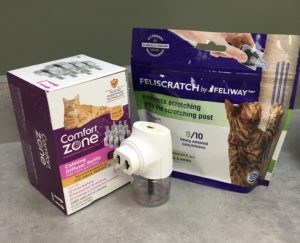Pheromones and Feline Communication
To us humans, smell is only important for deciding what food to eat or what perfume to wear. But for cats, smells are like a second language. With just their noses, they can learn almost everything they need to know about their surroundings and the other cats they meet.
Each of us has his or her own “signature odor”. These signature odors help cats recognize other cats, familiar humans and other animals by the way they smell.
“Semiochemicals” are special molecules that carry “messages” from one organism to another. The organism receiving the “message” will respond with a change in physiology or behavior. Most semiochemicals are transmitted by odors.
Pheromones
Pheromones are a type of semiochemical that helps animals of the same species message with each other. They are the same for every member of the species, and send the same “message” to each member of that species that detects them. For cats, these messages include marking boundaries, indicating sexual receptivity, and sending greetings. Lactating mother cats also produce a blend of “appeasing” pheromones that make kittens feel safe and reassured when their mothers are nearby.
Cats take in pheromones either by sniffing or using the Flehmen response. They release pheromones using glands located in:
- the lips
- the cheeks
- the pads of the feet
- under the chin
- at the base of the tail
- the area surrounding the teats in females.
When cats rub their faces on things, sharpen their claws on an object, spray urine, or leave their feces uncovered, they are depositing pheromones. These pheromones linger in the area and help cats “leave a message” for any other cats that pass by.
It’s easy to get frustrated with your cat when these messages damage your furniture or stain your carpet, but remember: your cat is trying to communicate, not destroy your home. Just giving them objects they’re allowed to “mark,” like scratching posts and other cat furniture, is often all they need to convince them to deposit their pheromones in more appropriate places.

Science and Pheromones: Synthetic Pheromones
Some feline pheromones have been synthesized in the laboratory and are available commercially. Feliway and Comfort Zone are two brands of synthetic cat pheromones.
Feliway Classic (Comfort Zone “Calming”) is a synthetic version of the pheromones cats deposit when rubbing their whiskers/lips on things. This particular pheromone marks the cat’s territory as safe and secure.
Feliway Multicat (Comfort Zone Multicat Control) is a synthetic version of the “appeasing” pheromone mother cats use to soothe their kittens, and can help reduce tension in multi-cat households.
Feliscratch replicates the pheromones released when a cat scratches something, marking territory and signaling that he was there. We can use Feliscratch to encourage cats to use a scratching post.
These products can be used alone or combined to help you tell your cat how you want him or her to behave. For example, you could use Feliscratch to make your cat’s scratching post more appealing, and also use Feliway Classic on other areas of your home to show your cat that they are already safely marked and there is no need to scratch there.
Feline pheromones are undetectable by human noses or other animals. So, you can’t smell the world the same way your cat does. But knowing the importance of pheromones in your cat’s world will help you better understand “why my cat does that”.


https://waterfallmagazine.com says:
https://waterfallmagazine.com
Fantastic website you have here but I was curious if you knew
of any user discussion forums that cover the same topics talked
about in this article? I’d really like to be a part of group where I can get responses from other
experienced individuals that share the same interest.
If you have any suggestions, please let me know. Thanks!
felinepurrspective_u3q4o6 says:
There are a number of groups/forums that deal with cat behavior. You could try posting a questions about pheromones on their sites. Thanks for for visiting The Feline Purrspective!